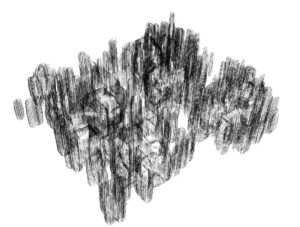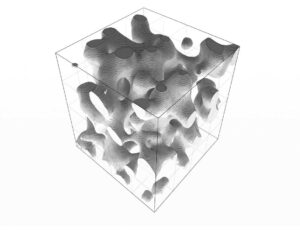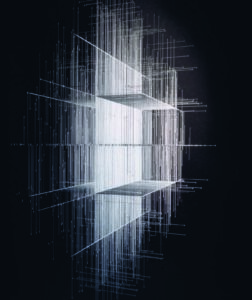
Metaversal Shift In Architecture
21 / 07 / 2022We are happy to share that Platform magazine has featured us! Here is our article called ” Metaversal Shift In Architecture ”
” Under the influence of the global pandemic, the digitalization of real economies has been accelerated in the last two years. During this time, we witnessed decentralized data processing models enable open networks and interoperable ecosystems. On a slower temporal scale, the transformation of architecture and how we perform architecture is also striking. As the legacy of the modern era, the phases of architectural production have been over-classified and reduced to isolated and separate knowledge areas. All this reduction has ultimately transformed architects into actors whose role is only to manage the phases of making buildings, mediating between engineers, contractors, government officials, and the law. Considering the challenging conditions of construction, such as high costs and unpredictable processes, much of architectural production has remained on paper. In the end, it seems that architecture has lost its role as the master builder of our modern cities in this recent period. In this impasse that architecture has perhaps reached, it seems to be on the lookout for alternative modes of production and environments where architecture can regain its autonomy. In this sense, meta cities and meta universes seem to architecture as an ideal alternative space where it can reinvent itself. However, the act of architecture goes back to the appearance of the first human beings on earth. And it will be a gradual process by which architecture departs from the physical crust of the planet and lands in a digital world. At this point, architects can be brave in using the most innovative tools and modes of production in order to define a transition between physical and digital spaces. It seems that it will be vital for the architectural discipline to speculate on the future of cities, ecology, space, art, culture, and communities. In parallel with this vision, one of our goals in Salon has been to produce ideas on how we will position our architectural practice within the flow brought by this metaversal shift. We had the opportunity to think and produce on this digital-physical transition within a series of projects during our practice since 2011. In the project Space Graph, we experienced a wide range of technological tools in our production phases, from VR installation to generative design and robotic performance. We had the chance to evaluate the relationship between time and space that is frequently addressed by the current approaches of modern physics. This evaluation resulted in an exhibition consisting of a series of algorithmic space generations and installations that can be experienced virtually. Space Graph was one of the first virtual space experiments of Salon. On the transition between digital and physical, we created a more comprehensive experiment with Refik Anadol in 2011. The Augmented Structures project took place in Istiklal Street in Istanbul as a public performance.Sound recordings were taken from the street at certain physical intervals turned into mathematics, and this mathematical data turned into an animated structural installation on the facade of the YKY building. In this way, the façade as an architectural element transformed into a living topographic surface involved in the public space as an active object. Digital tools and environments enabled the structure, which is confined to its physical limits in a way, to expand its architectural situation in an unexpected manner. All these digital expansions can solidify our predictions about how the architectural discipline, that has been building the physical world for 12 000 years, since the earliest communal structures, will exist in a virtual universe. The discipline of architecture can become the main actor that builds virtual networks and cities in the post-21st century. The capabilities brought by digital tools can lead architecture and space to reach an advanced state, free from all its physical constraints. For architectural practice which usually results in a single final for in physical space, there is now a chance to evolve into generative descriptions in virtual cities where users can intervene in parameters and where the space generates itself in real time. And perhaps more important than all these, architecture can embrace democratic forms of making in virtual cities interoperated by diverse communities. By bringing together non-location-specific communities enabled by distributed networks, architecture can lead to a collective creation of digital manifestations and utopias. Considering our passionate interest in urban and architectural utopias, we may begin to look for antecedents of these ideas. In his Situationist utopia New Babylon, Constant Nieuwenhuys had dreamed and produced a comprehensive study of a new urban space from the 1950s to the 1970s. He had portrayed the inhabitants of New Babylon as fully aware of their power over their surroundings and their ability to transform and recreate their urban environment. Constant dreamed of an uninterrupted process of creation and re-creation where entire urban space is surrendered to the most unexpected influences. Diving into New Babylon, we witness an organization of a collective mode of making where communities generate and recreate their spaces in various forms as an act of self-expression. The shift we are now experiencing towards virtual universes appears to bring us closer to this utopian ideal. The architectural experiments of Salon in the virtual environment seek to widen its scope based on this conceptual background. To this end, we experiment with participatory strategies to create a metacity project that we called SalonCity. This project aims to create a community that will follow the development of architecture in this virtual city. By developing various infrastructures and international collaborations, SalonCity aims to create resources and educational funds on virtual urbanization and virtual architecture. SalonCity is an algorithmic landscape that grows via generative urbanism and is built by its own community. Focusing on space, technology and ecology, this spatial experiment is a virtual architectural utopia. Here the topography exists as an interoperable collective digital cloud. It expresses the image of an interoperable urban labyrinth, where architecture is directly constructed and experienced and where diverse non-location specific communities are learning by making and learning from each other. In a universe where the boundary of architecture is not restricted by engineering and physics, the most important criteria of architectural conditions would be creativity. SalonCity aims to investigate the limits of architectural creativity in a universe where these boundaries do not exist. In this context, it aims to reveal a language of space guided by architecture, technology, and experimentation. As we are getting ready to launch this communal experimentation and share it with the public, we invite communities to contribute to this collective creation.”



